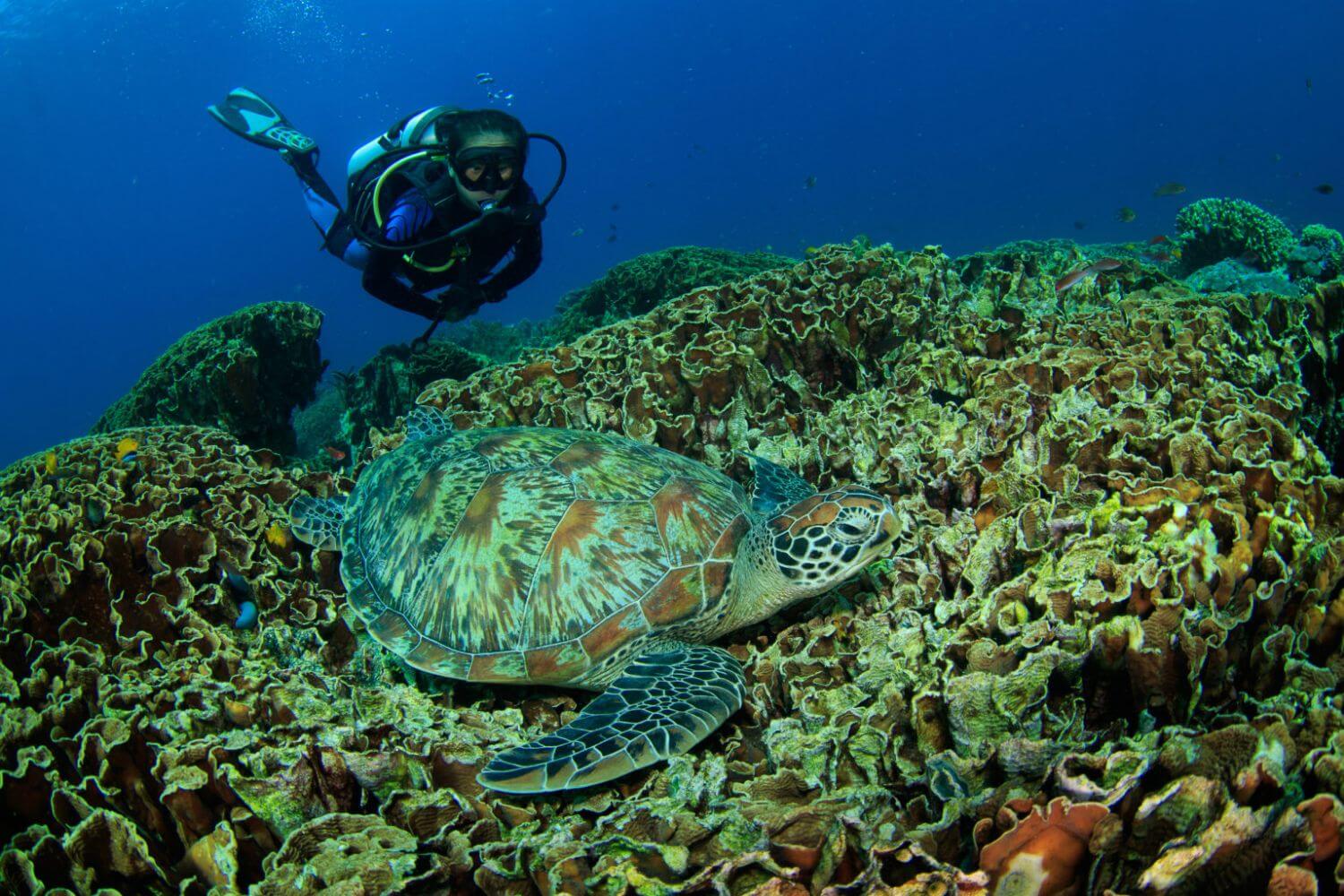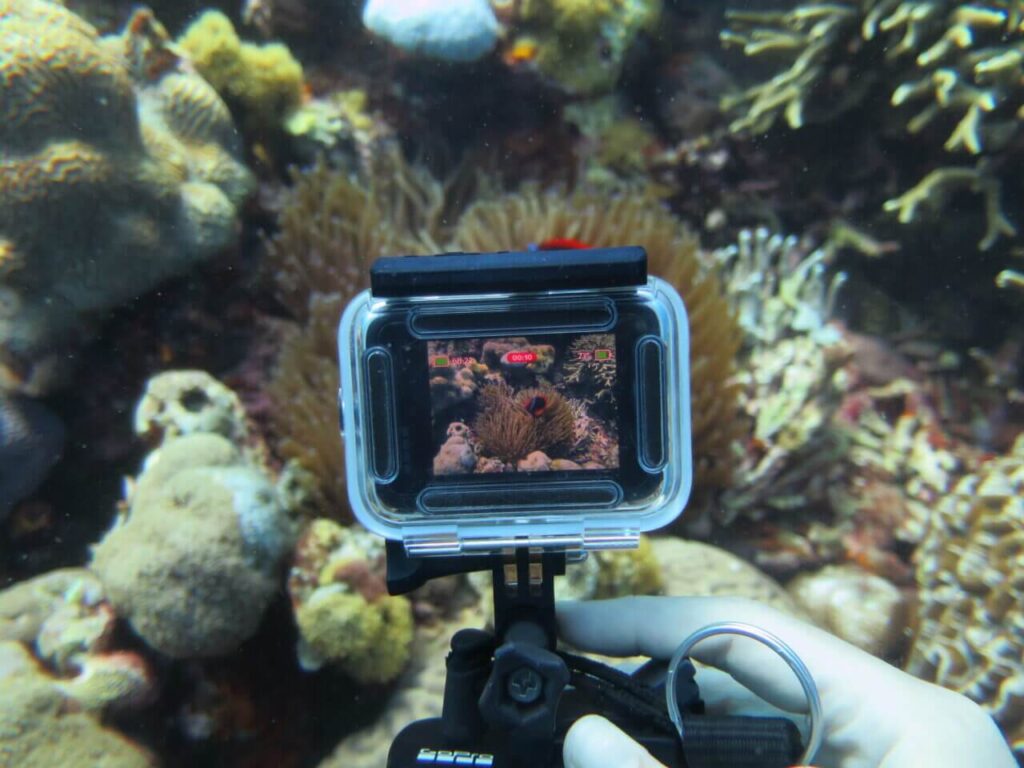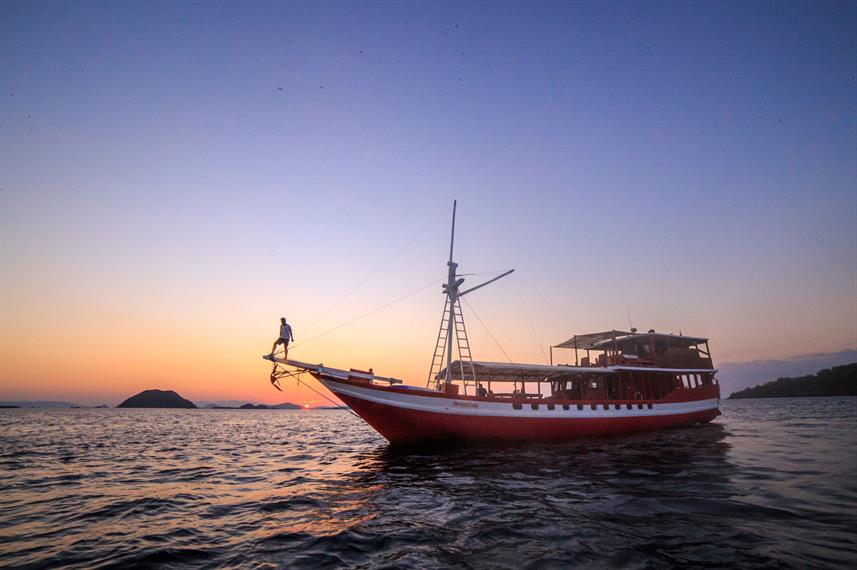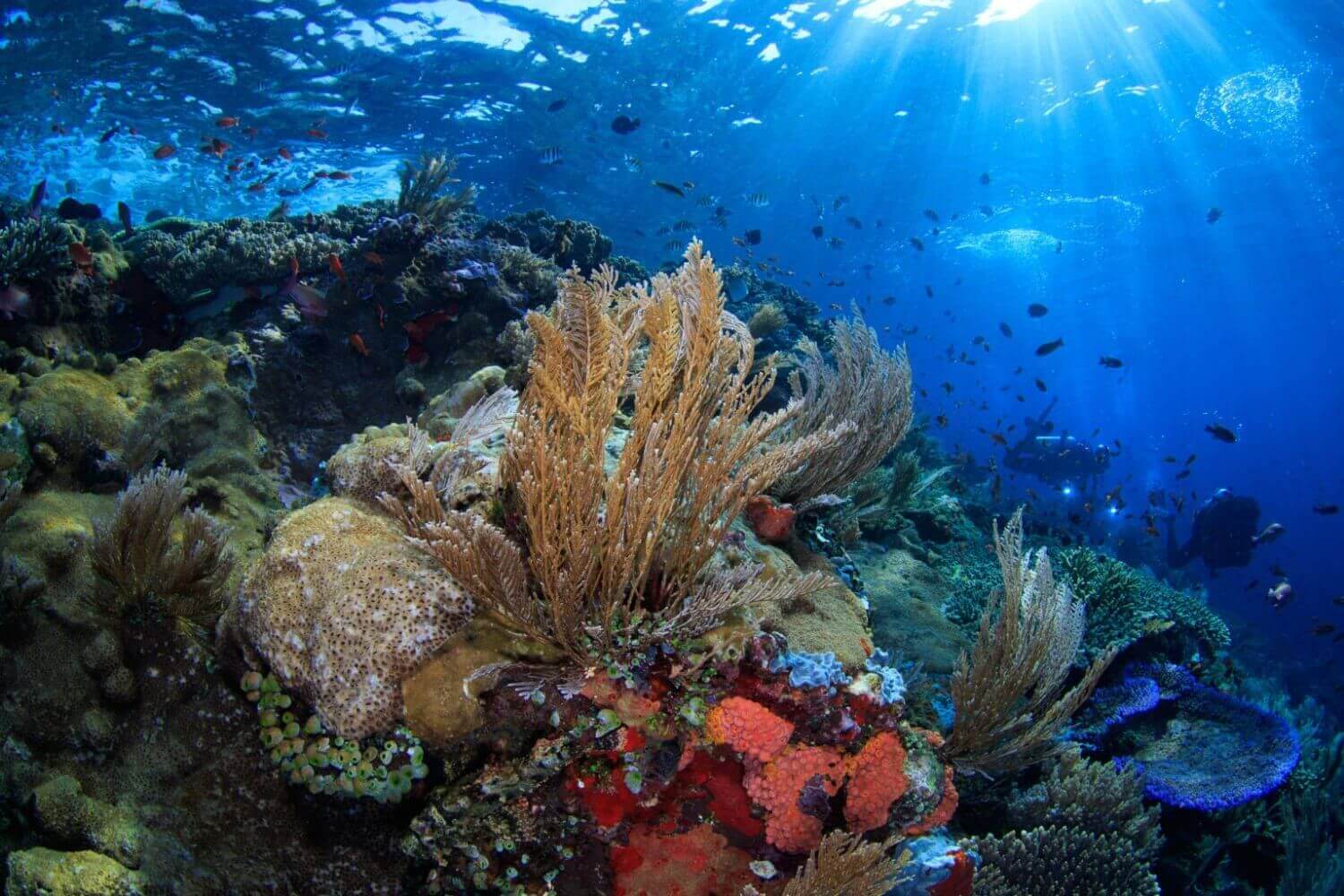
Scuba Diving Komodo is on the bucket list of virtually any diver who knows anything about this legendary national park, located in Indonesia, some 450 km east of Bali.
With pristine coral reefs and dramatic underwater landscapes; Komodo is unlike most prime dive destinations in that it offers both spectacular macro diving and the chance to witness large marine animals like reef sharks, mola mola and literally countless manta rays.
Due to the regions National Park status granting it special protection as well as the fact that it sits within the coral triangle; marine biodiversity at Komodo is next level!
However, something most people don’t realise is that Komodo national park is divided into three distinct regions – north, central and south; each of which have their own unique charms and ecosystems.
Which of these you get to explore will depend on how you choose to go scuba diving around Komodo; by liveaboard or dive resort.
Even when you’ve made this choice – there are dozens of different liveaboards and resorts, all of them varying significantly in dive routes, price and extra experiences.
To discover more about what it’s really like to dive Komodo, the best ways to dive there and everything else you’ll need to know before going, read on:
CONTENT:
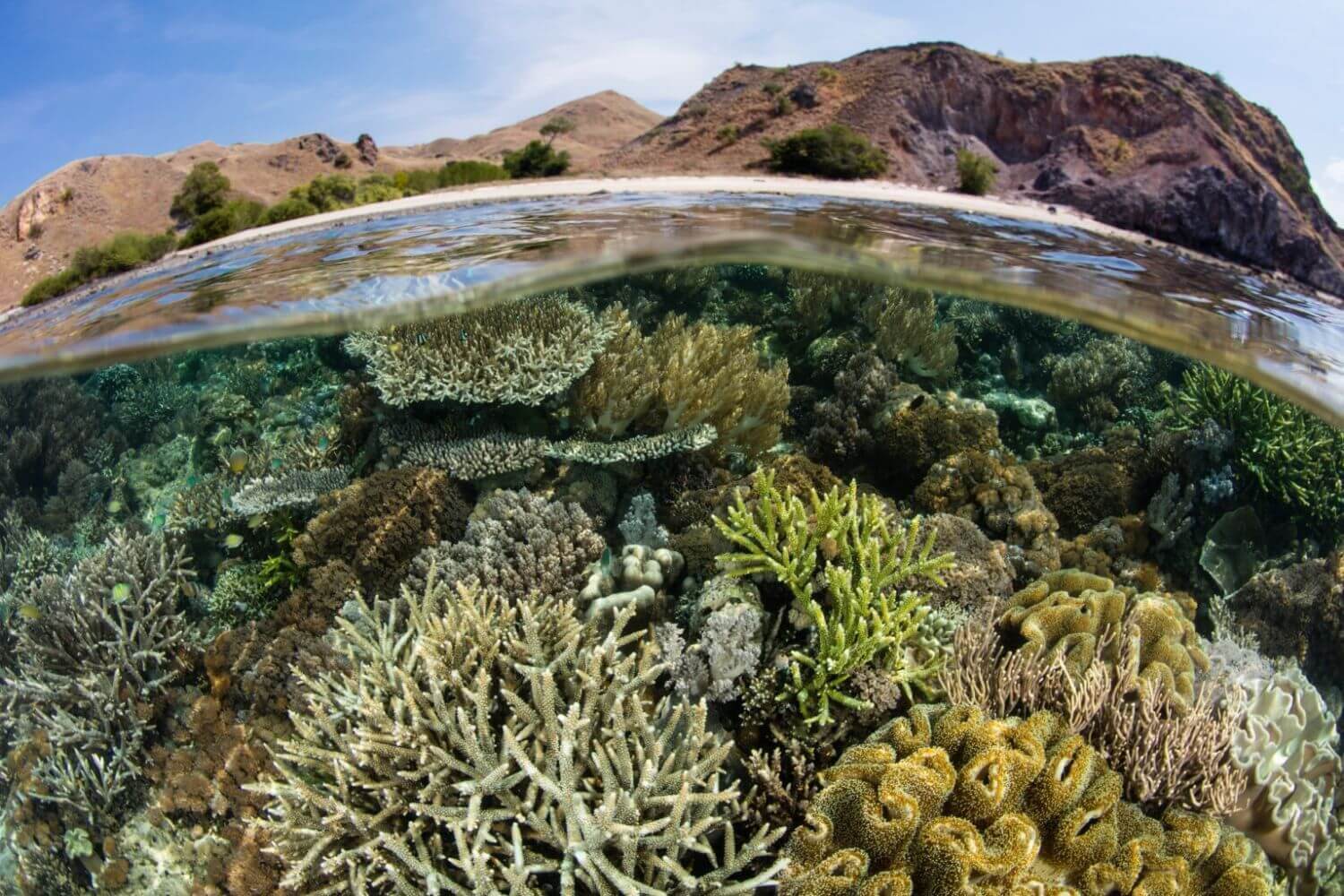
How to Dive at Komodo
Option 1 – Liveaboard:
This is where you live… aboard… a boat for a period of several days to weeks, whilst touring the best and most hard to access diving sites of Komodo National Park, including many which can only be accessed via liveaboard. In addition to this, some liveaboards also offer itineraries that visit additional Indonesian islands close (and sometimes not so close!) to Komodo National Park. More information on these routes as well as how to choose a Komodo liveaboard, is provided in the main Komodo liveaboard Reviews article.
Liveaboards vary a lot! Some are like affordable, backpacker hostels whereas others are extremely luxurious and include many incredible facilities like private cabins and spas as well as extra activites like water sports. Most liveaboards also include extra activities like beach visits and a chance to visit the Komodo Dragon Reserve on komodo island.
Personally, I recommend going with this option. Your time between dives will be spent on a much larger boat with more amenities than if you go with a diving school and you’ll get to do more diving, including around the more remote sites that can only be accessed in this way, meaning you’ll see much fewer other divers!
Option 2 – Diving Resort / Hostel:
Because the islands comprising Komodo National Park are protected, you can’t actually stay on them, which is a good thing as a lack of infrastructure keeps the surrounding waters clear and pristine.
Therefore, if you choose to go with a diving school; you will need to stay in the coastal town of Labuan Bajo which is on the island of Flores, East Nussa Tenggara Province. Labuan Bajo was once a small fishing village but is now a thriving tourist hub due to scuba diving. There are many restaurants and several great viewpoints, though not much else to do.
There are many diving schools which also double up as hostels at a range of price options. It takes several hours to get from Labuan Bajo to the dive sites of Komodo; which does mean a long journey, two times a day as well as not being able to visit the more remote north and south regions of Komodo. That said, you will still get to experience the central Komodo diving regions and these are amazing nonetheless!
If you do opt for a diving school, to save money as well as for convenience of arranging your dives, I highly recommend that you go with one also provides accommodation.
In my opinion, two of the best Komodo Dive Resorts are:
- Dragon Dive Komodo Resort – This recently renovated resort boasts 20 well appointed rooms with Nitrox facilities for scuba fanatics. They are also an authorised TDI Tech Centre teaching advanced tech diving courses. Plus they have two daily boat options: a speed boat for exploration and a liveaboard vessel! Find out more.
- Blue Marlin Dive Komodo – There’s a specialised dive centre, dive shop, pool, western & mexican inspired restaurant and a range of private rooms with private balconies offering sundecks and gorgeous views. With daily housekeeping, free parking and extra activities; this is a great choice for those who can splash out a little more. Go to booking page.
Komodo National Park Regions
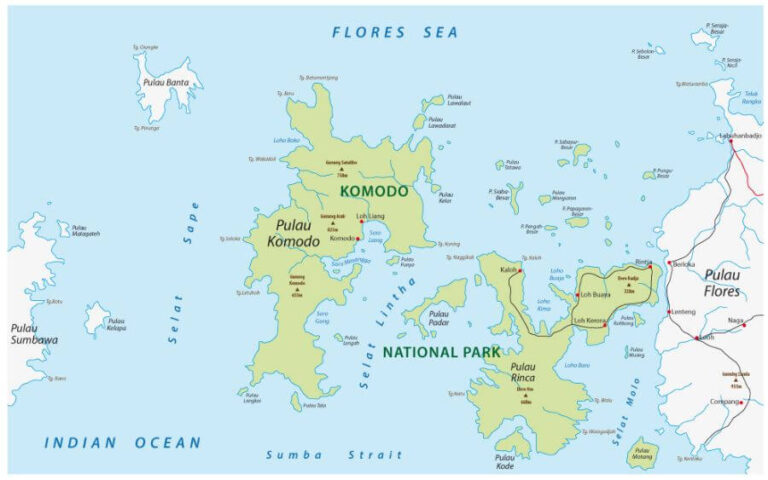
Attention: Komodo National Park is comprised of Komodo Island; the two smaller islands of Rinca and Padar as well as 26 small islets (see islands highlighted in green in above image).
In the following context, when referring to the “regions” of Komodo National Park, these are unofficial and loose categorisations, used by scuba diving groups to describe the broad areas of Komodo that can be explored by divers.
Each region has many dive sites, meaning you’ll need at least a few days diving at each region to truly discover it! In the descriptions below, only a couple of dive sites are described for each region, however the reality is that all three of the regions each have many dozens of dive sites to be explored.
#1 North Komodo Diving
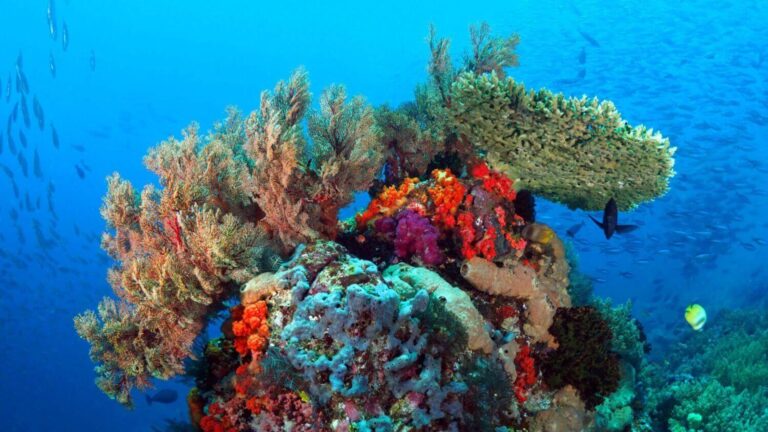
- Comprised of the northern region of Komodo island and the small islands around it.
- Many of the strongest drift dives in Komodo National Park are located here.
- Great for spotting reef sharks, rays, turtles and big fish. Also the best place to spot manta rays.
- Characterised by dramatic underwater landscape of rocky outcrops and pinnacles. These are covered in spectacular hard coral.
- During the rainy season (December – March), it may not be possible to dive this region due to northwestern winds creating extremely choppy waters.
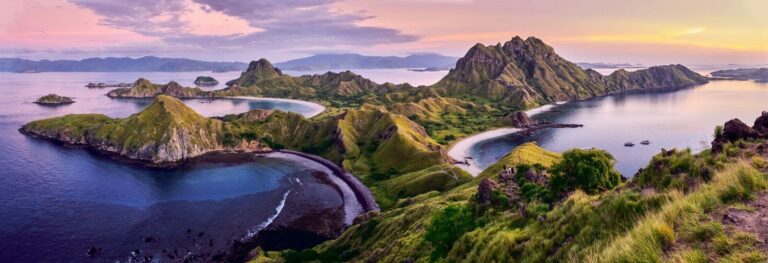
With excellent visibility and strong drift dives, North Komodo is characterised by a dramatic underwater landscape of towering pinnacles and rocky outcrops – adorned with a variety of colourful and healthy hard coral species.
These vibrant pinnacles reefs, which also include various sponges, are home to countless reef fish, including fusiliers, unicornfish and bannerfish. These fish attract predators such as reef sharks, barracuda, tuna and (in the early morning) dolphins, so that lucky divers can find themselves in the midst (but not part of!) a full blown hunt!
Other large pelagics sighted around the northern region of Komodo National Park include grouper, turtles, mobula rays, devil rays and yes: manta rays!
These mighty creatures do tend to steal the show, but for those who can pry their eyes away from the open waters and search between the intricate coral formations jutting from the pinnacles; there’s a fascinating mix of weird and wonderful critters to be spotted, including various species of pygmy seahorses, nudibranch and frogfish.
An all time favourite dive site is Castle Rock – comprised of blue dragon coral, golden table coral and bronze hued brain coral; it also features an assortment of pink, orange and yellow tube and vase sponges. Crawling and climbing amongst these are many starfish, blue eyed crabs and scorpionfish.
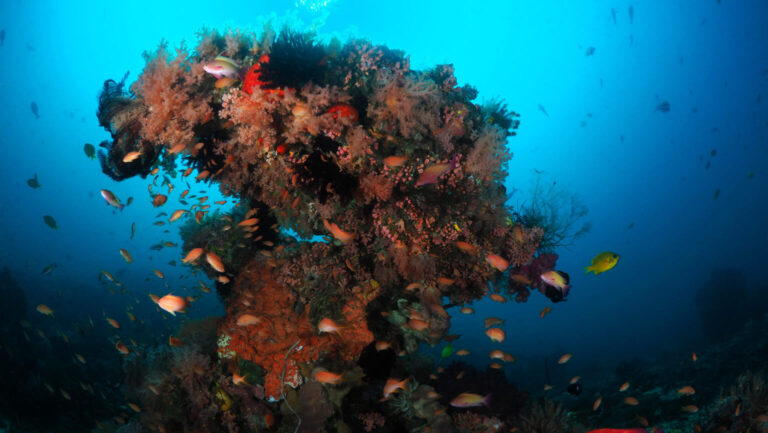
Another iconic northern dive site is Crystal Rock, where between the large yet delicate soft coral, one can witness octopus, ribbon eels and seahorses. Meanwhile, the surrounding open waters are a great place to spot turtles, trevally, crocodile fish, reef sharks and mackerel.
Many of the drift dives provide unique passage ways between the islands; which make for superb and adrenaline soaked drift dives; during which one will be carried over a variety of sandy slopes, rocky outcrops and mighty pinnacles; virtually all of them covered in magnificent coral and surrounded by various eye popping pelagics.
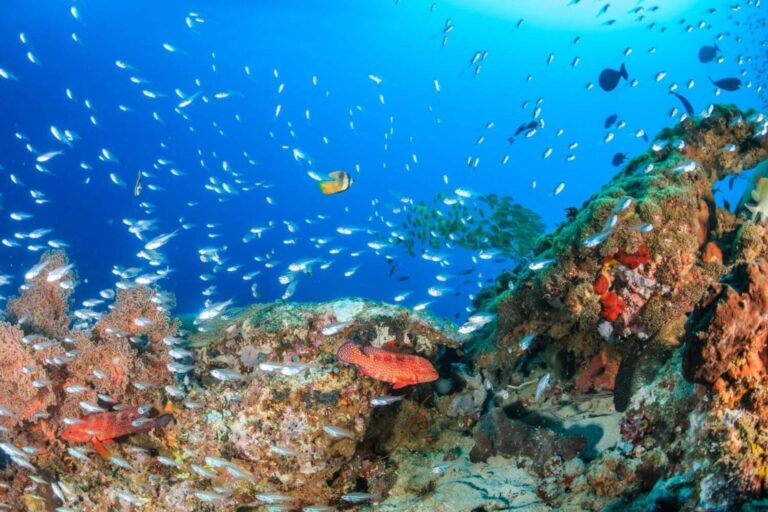
For the absolute best opportunity to dive with Manta Rays, look no further than Karang Makassar Reef, which is also aptly known as Manta Point. This site may not have rich coral growth or interesting underwater scenery, but it is still one of the most interesting dive sites on the Komodo Archipelago due to the many manta rays which can be seen everywhere around this Komodo diving site.
Here, the manta rays go towards the sea surface when they are feeding and closer to the seabed to be cleaned, meaning that at any depth and at any time, divers can see these gentle giants in high numbers.
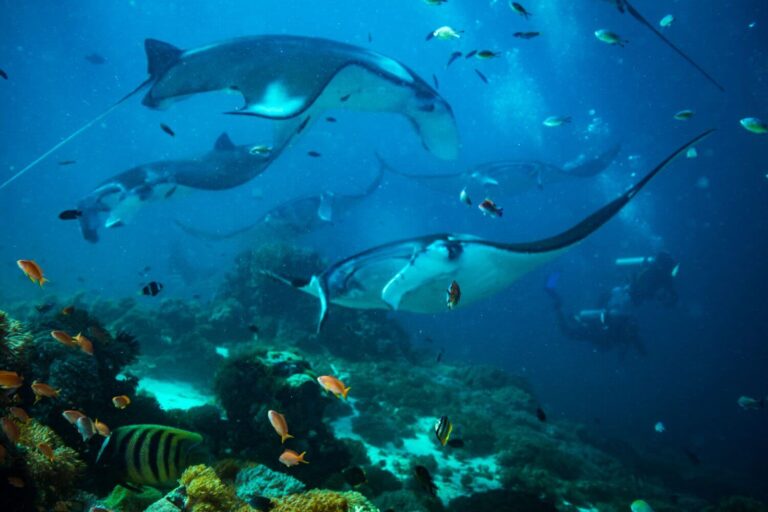
#2 Central Komodo Diving
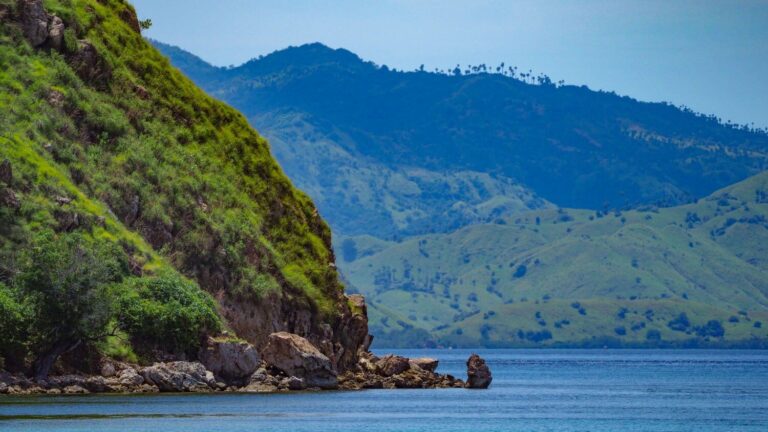
- Without a doubt the most varied of all Komodo diving is in the central region.
- Expect wall dives, drift dives, pinnacle dives, protected coral gardens, muck dives and more.
- Comprised of central Komodo island, Padar island, upper Rinca island and many of the smaller islands surrounding them.
- A range of marine life is encountered here such as turtles, reef sharks and all kinds of fish. Manta rays and whale sharks can also be spotted, but the best regions for these two species are north and south.
- The central region is the best for muck dives and small, whacky critters!
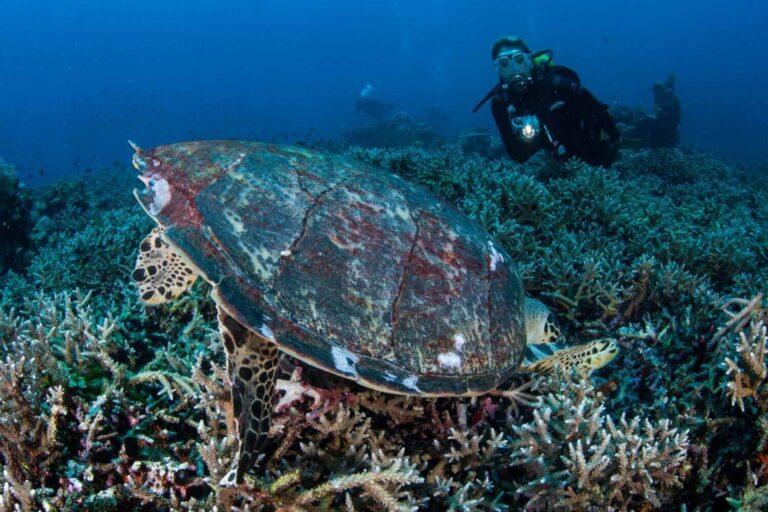
Comprising the largest part of Komodo National Park, the central region is well known among local divers for the insane variety it possesses. There is a stark contrast in terms of underwater topography, diving sites and marine life here.
In addition to featuring excellent drift dives over stunning coral gardens, towering pinnacles akin to those found further up north as well as manta ray cleaning stations (albeit not as many as up north), central Komodo is also the best place for muck diving.
Siaba Besar is a favourite muck diving site; it is a horseshoe shaped bay, home to a stunning coral reef where broadclub cuttlefish, hairy shrimp, wonderpus, frogfish, seahorses and a large host of curious other critters await discovery. It is also a great place for spotting reef sharks, stingrays and turtles!
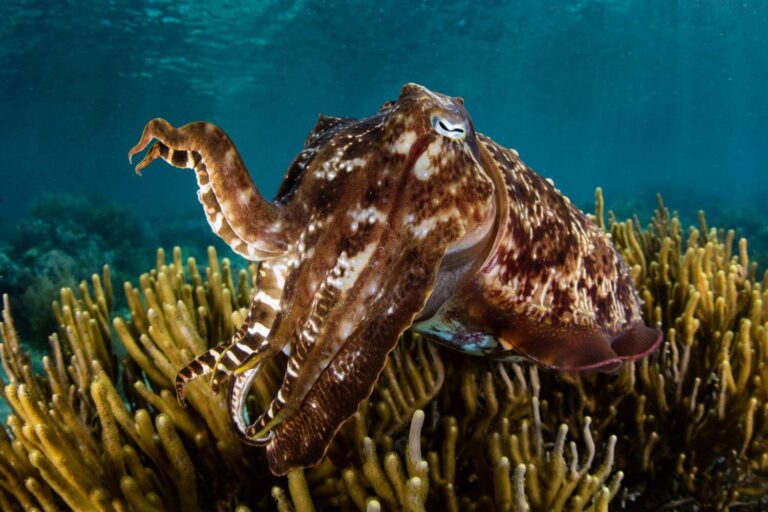
Being a little more sheltered, central Komodo is also the only place where some dive sites are not so prone to strong currents. Now… don’t get me wrong. By and large, Komodo National Park is really only suitable for experienced divers who at least have their advanced open water certification.
But around the central region there are a few sites that can be pretty easy to dive and may even be suitable for open water divers. The lack of currents means everyone can relax and take more time to witness what’s going on around them.
A great example is Sebayur Kecil, a beautiful island that allows two very distinct dives. Along the right shoulder of the mooring line is Mini Wall, a wall dives that meets the sandy bottom at around 35 meters.
The wall is teaming with schooling fish like red tooth triggerfish and blue streak fusiliers as well as anthias as regular guests. One can also spot lionfish, nudibranch and cuttlefish cruising up and down the drop off.
There’s an extensive sandy slope separating mini wall from an immaculately pristine coral garden. Living along this slope are many garden eels, cuttlefish and garden shrimp.
Or, if you continue along the left shoulder, the sloping reef meets the sand at around 17 meters, where there is a great opportunity to come face to face with pygmy seahorses, leaf seahorses and a variety of frogfish.
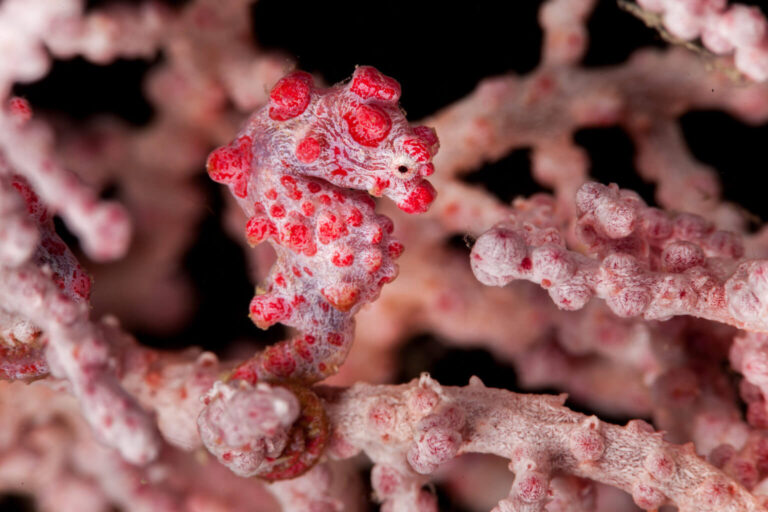
On the other end of the spectrum, central Komodo does still have many superb drift dives that are perfect for those keen on large marine life. One can spot reef sharks, turtles, manta rays and sometimes even Dugong if they are lucky!
One great example is Batu Tiga, which is situated between central Komodo and Padar island in the Linta Strait. Without a doubt one of the most current affected dive sites of central Komodo, it is a jagged and rocky reef that extends below the surface towards Komodo island. Due to the stronger currents, much of the coral here is stunted, which makes for an interesting and alternative looking reef.
Down in the deeper water and below the reef, are many large boulders which provide hiding spots for groupers and octopus. Mantas, giant trevaly and other large pelagics are frequently spotted here.
There are so many other kinds of great dives to be had around central Komodo. I tell you about Tatawa Kecil where countless anthias live amongst the beautiful coral gardens and Dugong are sometimes spotted – or Mawan with it’s many white tip reef sharks and rarer bamboo sharks… or even the baby reef sharks of Pengah Kecil…but the best way to fully appreciate the diversity of central Komodo is simply to see it for yourself.
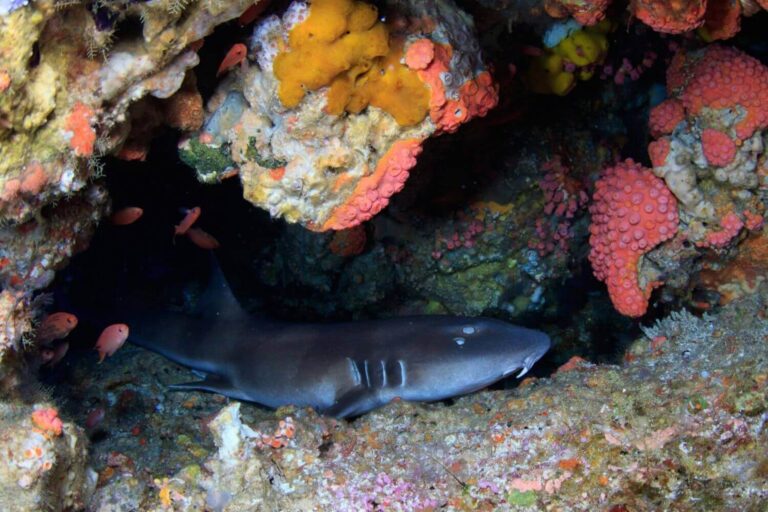
#3 South Komodo Diving
- Many filter feeders are found here, including Manta Rays and Whale Sharks.
- The southern reefs are mainly formed from soft coral including branching corals and sea fans.
- Comprised of south Komodo and South Rinca as well as the smaller islands around them.
- This is the best region place for seeing eagle rays and Mola Mola / Sunfish!
- Less often visited than the central and north regions
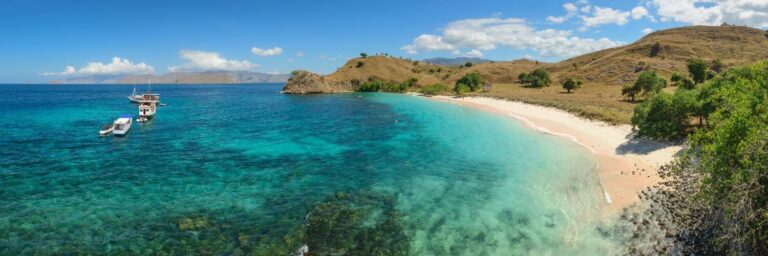
The waters of south Komodo are a little cooler than the north and central regions, due to the large upswellings of water from deep within the Indian ocean coming into contact with the continental shelf. With them, these upswellings bring many nutrients which attract scores of filter feeders, making many of the dive sites here excellent for spotting manta rays and whale sharks.
This is also the most infrequently visited region – due both to it’s considerable distance from Labuan Bajo making it only accessible via liveaboard as well as the fact that the diving season here is different to north and central regions (more on this info in the when to dive section!)
However; if you get to south Komodo national park and you go at the right time, the rewards and unique value of this region are well worth the effort.
Whilst most of the north and central reefs are mainly formed of hard coral, the reefs of the southern region are largely comprised of soft coral; namely huge gorgonian sea fans and whip corals that take the limelight. Many sea apples and nudibrach are found amongst them.
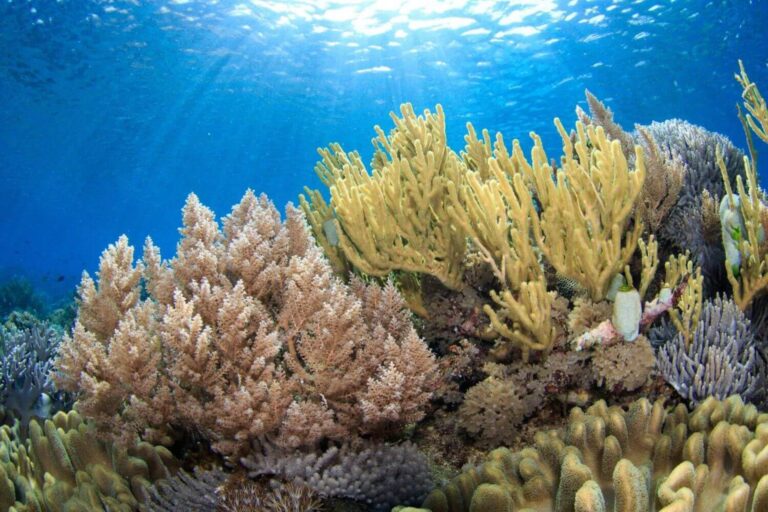
South Komodo is the best region to spot large schools of devil rays; especially around the Pillerstien sites which boast epic topography with dramatic walls, swim throughs and mighty whip corals.
Pillerstien is nicknamed “surge city” on account of the fact that it has no shelter from the surge of the Indian Ocean and consequently experiences strong currents that make for fantastic drift dives.
Divers regularly spot manta rays and whale sharks as well as huge schools of graceful devil rays.
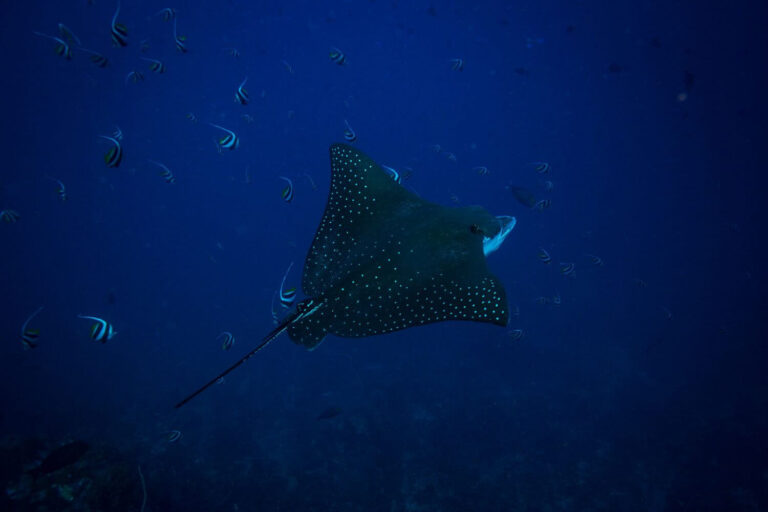
Another defining feature of the southern region of Komodo is that between July – August, it is the best region to witness the mighty Mola Mola also known as the oceanic sunfish.
Mola Mola usually live very deep down, rising to the surface as if to soak themselves in sunlight hence the nickname sunfish and rarity of sightings. If you are going to spot these gentle giants, south Komodo is arguably the best place to do it, thanks to the upswellings bought up from the Indian Ocean.
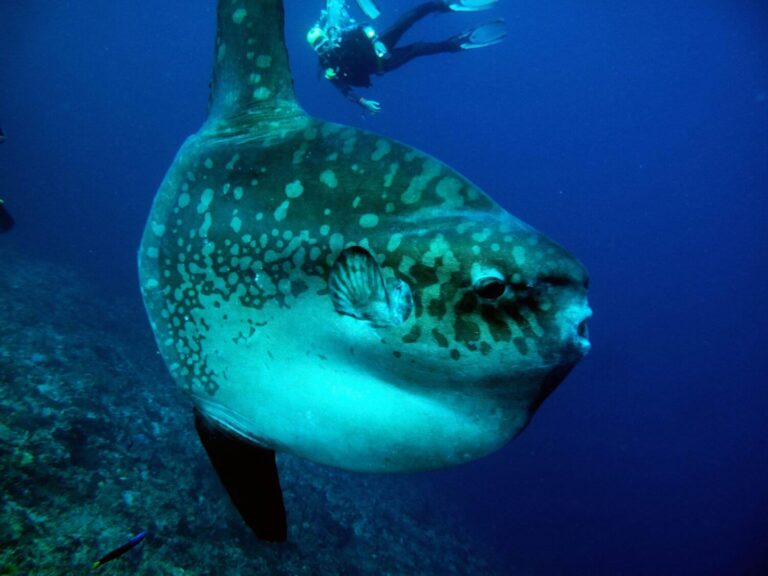
Komodo Scuba Diving Season
Scuba Diving Season in Komodo National Park is possible all year round. Best water conditions in the central region; where most dive operators and liveaboards operate, is from May – September. But let’s take an even closer look:
You see, there’s more to Komodo Diving Season than meets the eye. Most information sources will describe the diving season of the north and central regions of Komodo National Park as if these apply to the entire national park.
However, in terms of water conditions, the diving season of the southern region of Komodo National Park are the opposite to that of the north and central regions:
Best Water Conditions (good visibility, non choppy and warmer waters):
- North and Central Regions: May – September. (Rainy Season is November – April. From January – February, rough waters in the Northern Region may mean it’s not be possible to dive there).
- Southern Region: November to April. (July to August = murky and rough waters here).
Marine Life Seasonal Activity:
Whilst much of the iconic marine life found Komodo is resident and can be spotted all year round – such as reef sharks, turtles, fish, crustaceans, mollusks etc, some creatures are more easily seen at certain times of the year.
- Manta Ray Season: In Komodo, some Manta Rays comprise the resident population; those that live there all year round. These can be spotted on every month. However, from the months of December – February, plankton blooms attract many non-resident Manta Rays from far and wide to feed, resulting in much higher numbers as there are both resident and non resident Manta Rays!
- Whale Shark Season: The December – February plankton blooms also attract whale sharks, meaning it’s also the best time to spot them.
- Mola Mola: Although there is the possibility of spotting the elusive Mola Mola on any month (if you’re lucky!), generally August is viewed as the most likely time to spot these mighty and mysterious fish.
Danm, that’s a lot. info – when the hell should I go!? Honestly, don’t get in too much of a flap about this one. There are countless dive sites around Komodo National Park.
Dive schools and scuba diving liveaboards monitor the weather and adjust the dive sites they visit accordingly; to ensure you’ll dive at the best locations for whatever time of year it is; specifically in relation to the season, weather and lunar cycles of the time you go.
And honestly, Komodo offers incredible scuba diving all year round, provided you visit the right place at the right time, which your diving school or liveaboard will ensure you do.
- If you are choose to go with a diving school instead of a liveaboard you’ll end up diving the central region, in which case, your best bet is probably to go between May – September for the best water conditions. True, there’s more Manta Rays from December – February, but you’re still virtually guaranteed to see multiple members of the resident population outside of this period! Of course if you’re on a mission to see as many manta rays as possible, adjust accordingly and go from Dec – Feb.
- If you are choose a diving liveaboard, you have far more flexibility for when to go; as not only can liveaboards visit the north and south regions, many also extend their itineraries to other nearby Indonesian islands outside of Komodo National Park. Whichever month you go, they’ll take you to the very best region and often include additional dive sites around, but technically not within Komodo National Park as well.
Can Beginners Dive at Komodo?
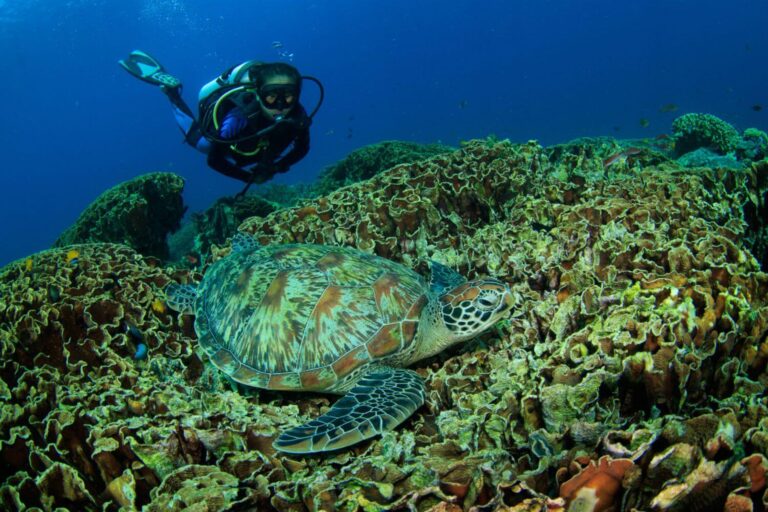
Not really. The vast majority of Komodo scuba diving sites experience strong currents and tend to be drift dives. You’ll need your advanced open water certification before you experience them.
That said, a few dive sites do experience a lack of currents and are suitable for open water divers. If you’re an open water diver, check with your diving school or liveaboard beforehand.
It may also be possible to arrange taking scuba diving courses with some dive schools and liveaboards whilst you’re there. That said, if youc an, I highly recommend attaining your advanced open water cert before you go. You’ll have more time to enjoy the full scope of diving that Komodo has to offer!
Chances are, you’ll be coming from some way away, so you deserve to be able to make the most of it from the moment you arrive!
Of course, if you have your advanced open water cert but it’s been a while since your last dive, this is far less of an issue. You can easily arrange to take a scuba refresher course which lasts just half a day and then you’ll be good to go! If you need, you can check out these vital scuba diving refresher tips, to help you remember that vital scuba info!
Getting There:
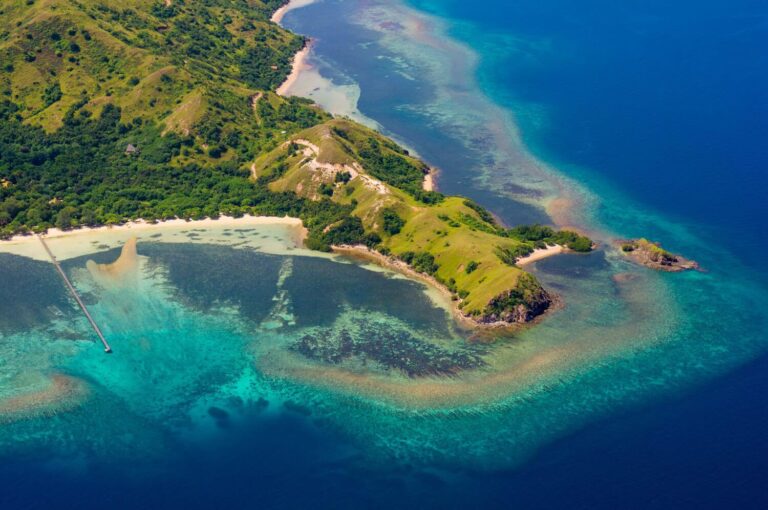
However you decide to dive at Komodo, getting there is the old same story. You’ll need to fly into Komodo International Airport. If you have gone with option 1) liveaboard, you will be picked up and transferred to the liveaboard from here, easy as! Details will be provided upon booking the liveaboard.
If you’re going with a dive resort/ hostel, then you need to get to Labuan Bajo, but this is a mere 15 minute car ride away. You’ll find many taxis outside the airport, who will be all happy to take you.
Ecology, Geography & History in a Clamshell:
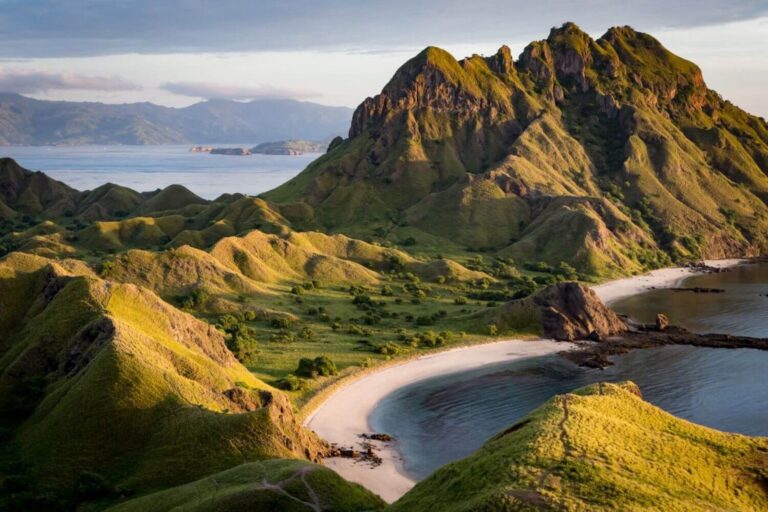
Komodo National Park comprises a series of islands along the coastal section of western Flores. These islands include the famous Komodo island as well as Padar and Rinca islands plus 26 more smaller islands, most of which. lie between the northeast of Komodo island and the west of Flores island.
All of the national park islands are of volcanic origin and consequently the underwater topography around many of the dive sites here is both dramatic and varied, with mighty pinnacles, rocky overcrops and underwater caves.
Fringing and patch coral reefs are extensive and best developed on the north east coast of Komodo. These are mostly comprised of hard coral species, of which there is a staggering variety. That said, the southern regions of the national park do harbour some spectacular soft coral reefs.
The marine biodiversity here is incredibly varied and includes manta rays, whale sharks, eagle rays, devil rays, ocean sunfish, tuna, pygmy seahorse, frogfish, nudibranch, octopus, cuttlefish, sponges and tunicate…to name but a few species!
Various cetaceans inhabit the adjacent waters – from dolphins to sperm whales and even blue whales, whilst endangered dugongs have also been confirmed in Komodo’s waters!
Part of the reason for the insane biodiversity within the waters around Komodo is due to the fact that this region sits within the coral triangle, an area that covers much of Indonesia, the Philippines and New Guinea. Despite only covering 1 % of the worlds total ocean, the coral triangle represents 30% of the worlds’ coral reefs and has the world’s greatest marine biodiversity.
On land, the terrain of Komodo National Park is rugged and characterised by rounded hills with altitudes of up to 735 meters. It’s one of the driest regions in Indonesia with an annual rainfall of just 800 – 1000mm. The vegetation is mostly savannah in type, although cloud forests do exist at several of the higher altitudes as well as some mangrove forests around the sheltered bays of the larger islands.
Komodo dragons are found on Komodo and Rinca. Only discovered by the scientific community in 1910, they are the worlds largest extant lizard reaching a length of 3 meters / 10 feet. It’s possible to go on a day tour to Komodo island to witness these fearsome looking beasts up close.
Not much is known of the early Komodo islanders other than that they were subjects of the sultanate of bima. That said, the islands distance from bima, means that these peoples would probably have had little to do with Bima other than fulfil occasional demands for tribute.
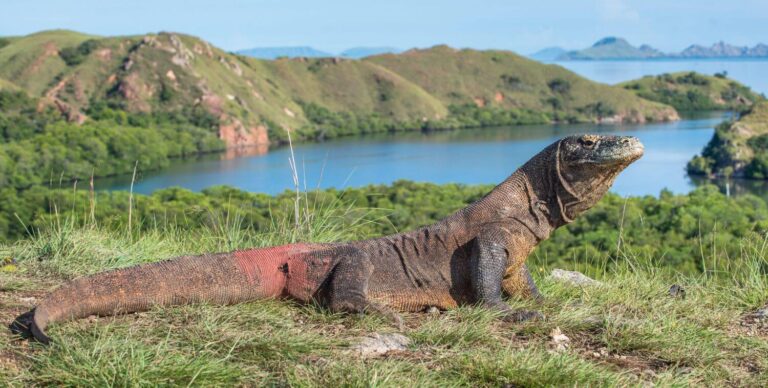
Marine Conservation & Sustainable Diving:
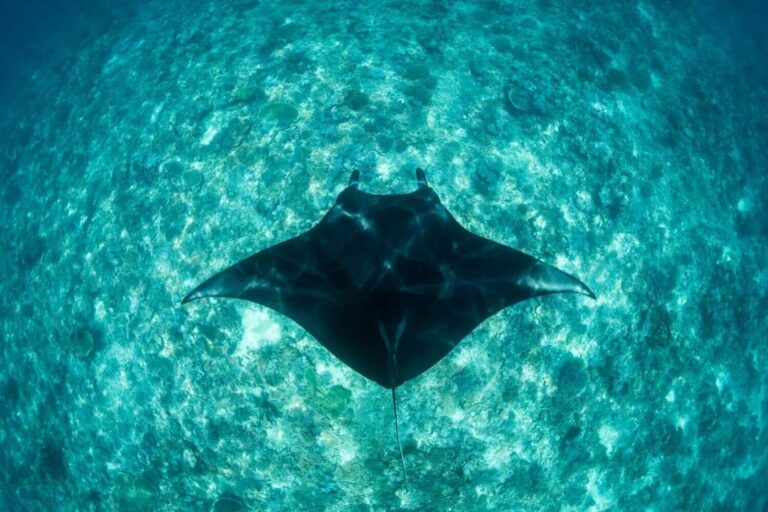
Komodo National Park was established in 1980 and declared a world heritage site and Biosphere Reserve by UNESCO in 1991.
Originally, the park was established in order to conserve the unique komodo dragon, of which only some 5,700 remain; the majority of these are on Komodo and Rinca islands (the rest are on nearby Flores and Gili Motong).
However, conservation goals have since expanded to protecting not only the terrestrial biodiversity of the Komodo region, but also the surrounding marine life. The park receives considerable resources and support from the central government of Indonesia, which has a special program for ecotourism management.
Regular patrolling of the marine and terrestrial areas is carried out for law enforcement in order to address illegal fishing and poaching.
It should be noted that increasing levels of tourism and matters relating specifically to the komodo dragon are currently the major management issues right now. A broadening of the management focus to address issues within the marine area of the park, is required to ensure long term effectiveness of conservation.
The Indonesian government has actually considered forbidding all access to Komodo National Park in fear that over-infrastructure there may posse a threat to Komodo Dragons in the long term. More people equals less home range for the Komodo dragons which means less prey and breeding grounds.
However, a great deal of the local population heavily rely on tourism for their work. There is the very valid concern that if tourism in Komodo island were to be cancelled or limited, it would negatively affect the local economy, leading people to return to blast and cyanide fishing.
Currently it costs around $10 to visit Komodo National park, which doesn’t go a long way towards the upkeep of the park, yet does encourage everyone to go – thus increasing the likelihood of an overcrowding problem in the near future.
In the last year, there’s been talk of increasing this fee to $1000. Before people moan about how this will prevent budget backpackers from seeing the dragons, think about it like this:
At the end of the day, if you’re a privileged tourist who can afford to stop working and go gallivanting around the world, chances are that no matter what kind of budget you’re on -you are spending at the very least $1000 a month, probably more.
So if you truly want to see the Komodo Dragons up close, yet don’t have that much money – you should be willing to shorten your trip by a few weeks. Paying such a fee would massively benefit these animals and the national park.
Of course you’re perfectly entitled to not want to pay that fee, if seeing the dragons up close isn’t that interesting to you. But if it is truly meaningful to you; you’ll find a way to make that theoretical $1000, even if it means shortening your trip by a few weeks. And if. that seems like an injustice, then maybe you were only interested in going there for bragging rights or a selfie.
At any rate, this fee is only for those who want to set foot on komodo island, which is currently seen as more of a potential threat to the park than simply diving.
Ok, so fees aside, what else is one to do to ensure their trip to komodo is a sustainable one? Hopefully, you already know to avoid all plastic, use reef safe sunscreen and generally not be a dick towards all living things that you met on you travels – from the largest komodo dragon (which in fairness if you do try to be a dick to, will probably rip off your arm) to the smallest insect.
But there’s more you can do. If you’re going to dive around Komodo, visit the park or both, I strongly recommend you familiarise yourself more with the conservation efforts there in greater detail than I can explain on this page.
Check out or even contact Komodo Survival Programme for a detailed brief of conservative efforts taking place there, adopt a Komodo dragon or even go on a liveaboard where a large portion of the profits go towards marine conservation, like Coralia.
As always, arm yourself with as much knowledge regarding the latest info there regarding sustainable travel and remember that the future of the environment is in our hands!
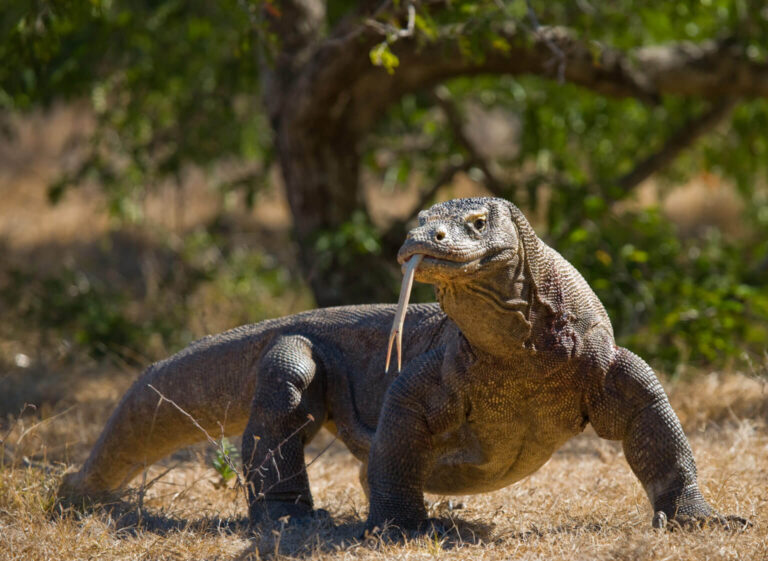
Komodo Diving Squad DEBRIEFING:
That’s all for now! We’ve covered a lot – from what makes the waters of Komodo National Park unique to dive in, when to go, how to get there, responsible tourism and the best way to experience scuba diving in this unique and incredible part of the world.
Don’t forget to check out these Komodo liveaboard reviews and if you have any more questions feel free to send us a message on the Diving Squad contact page!
Support the Squad!
Some of the links in our content are affiliate links. This means that if you buy a product, book a liveaboard, book accommodation or purchase insurance, we earn a small commission at no extra cost to you. Thanks!
